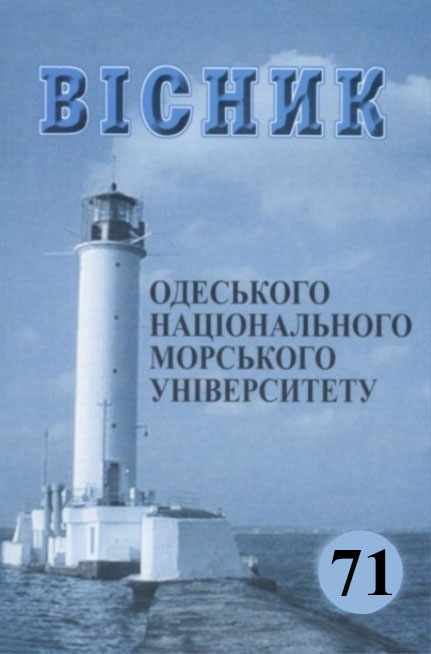Analysis of using possibility the deep-sea oil and gas production platforms for the Black sea conditions
Main Article Content
Abstract
The development of offshore oil and gas fields is a priority task for the world economy development, because over the past few years, about 70 % of new discoveries of oil and gas fields in the world have occurred in marine areas, and the demand for hydrocarbons will increase by about 15-20 % over the next 10 years. For Ukraine, gaining independence in the production of energy carriers was relevant before the start of the war and will be especially important during the reconstruction of the country after the end of hostilities. Until 2014, the level of development of the Ukrainian shelf was about 3 %, and daily production in the Ukrainian sector of the Black Sea shelf was about 2 million cubic meters. m. of natural gas. However, it should be noted that a significant part of hydrocarbon resources (27 %) is concentrated at depths of 5-7 km. 7043,5 million tons of initial potential hydrocarbon resources, or 75,5 % of their total amount, are located on land, and 2279,2 million tons (24,5 %) are on the shelf of the Black and Azov Seas [1; 2]. JSC Chornomornaftogaz is the only Ukrainian company that has the right to carry out the entire range of work related to the exploration and production of energy carriers on the sea shelf. The company has 17 deposits on its balance sheet, of which 11 are gas, 4 are gas condensate, and 2 are oil. The total reserves of all deposits amount to 58,56 billion cubic meters of gas, 1,231 million tons of gas condensate, and 2,530 million tons of oil. As of 2014, Chornomornaftogaz developed 6 gas, 3 gas condensate, and one oil field, operated 10 offshore stationary gas production platforms and 44 gas distribution stations. Odesa and Bezymenny gas fields were put into operation in November 2012 to increase production volumes. The Subotyn gas field was under development until 2014. Before the beginning of the Russian aggression, the DJSC Chornomornaftogaz was negotiating to connect the American companies ExxonMobil, Chevron, and Texaco, which have experience working at great depths, to develop deposits in the deep-water part of the Black Sea shelf (more than 800 meters). Currently, the offshore oil and gas industry is making a strategic move to the area of the deep-sea edges of the continents, considering them as a new source of extraction of hydrocarbon raw materials.
Article Details
References
2. Fyk, I. M., Fyk, M. I., & Fyk, I. M.. Prospects of long-term development of Shebelynka gas-condensate deposit in conditions of stocks recovery. Visnyk of V. N. Karazin Kharkiv National University, Series «Geology. Geography. Ecology"», 2019. – № 50. – Р. 63-76. https://doi.org/10.26565/2410-7360-2019-50-05
3. Kushnyr, V.M., Dushko V.R. and Kramarʹ V.A. Vozdeystvye poverkhnost- nykh hravytatsyonnykh voln na prybrezhnye okeanotekhnycheskye sooru- zhenyya // Vostochno-Evropeyskyy zhurnal peredovykh tekhnolohyy, 2013. – № 66. – С. 36-41.
4. Yvanov, V.A., Kushnyr V.M., Sovha E.E. Otsenky sostoyanyya morskoy sredy v rayonakh neftehazodobychy Ukrayny // Heolohyya y poleznye yskopaemye Myrovoho okeana, 2011. – № 3. – С. 92-105.
5. Yaremiychuk R.S. Osvoyennya vuhlevodnevykh resursiv Сhornoho morya // HO Ukrayinsʹka naftohazova akademiya, sektsiya Heotekh-nolohiyi, 2020. – № 3. – С. 36-40.
6. Kushnyr V.M., Vozdeystvye morskoy sredy na systemy osvoenyya shelʹfa: Monohrafyya // V.M. Kushnyr, V.R. Dushko, S.V. Fedorov. – Sevastopolʹ: SevNTU, 2009. – 309 s.
7. Fedorov, S.V. Osobennosty yspolʹzovanyya modely SWAN dlya rascheta poverkhnostnykh voln v Kerchenskom prolyve // Ékolohycheskaya bezopasnostʹ prybrezhnoy y shelʹfovoy zon y kompleksnoe yspolʹzovanye resursov shelʹfa, 2008. – № 16. – С. 303-313.
8. Mohamed A. El-Reedy Offshore Structures: Design, Construction and Maintenance, Second Edition: text – Houston, Texas, USA: Gulf Professional Publishing, 2019. – 690 р.
9. William L. Leffler, Richard Pattarozzi, Gordon Sterling. Deepwater Petroleum Exploration & Production: A Nontechnical Guide. – PennWell Corporation, 2011. – 350 p.
